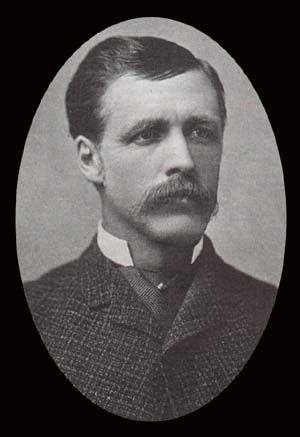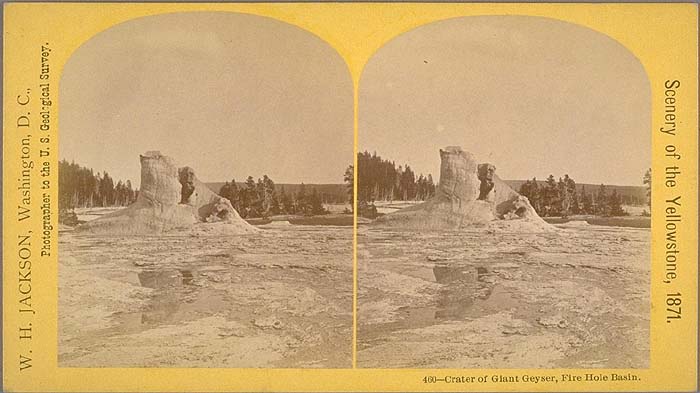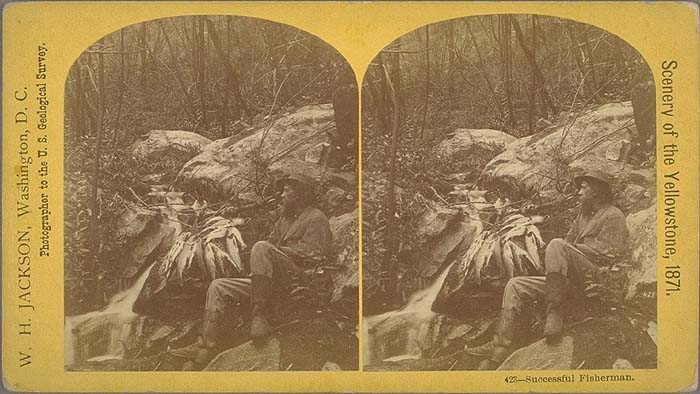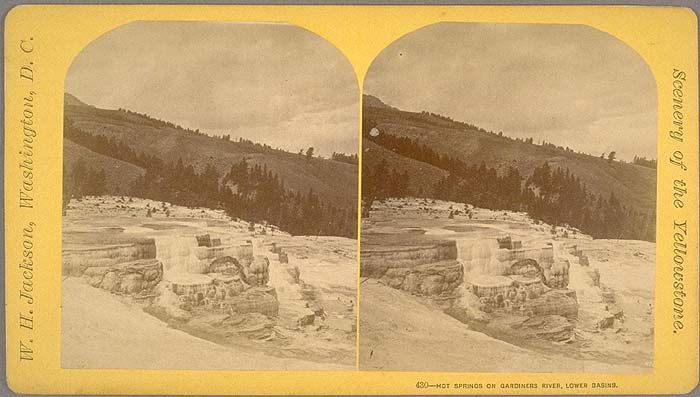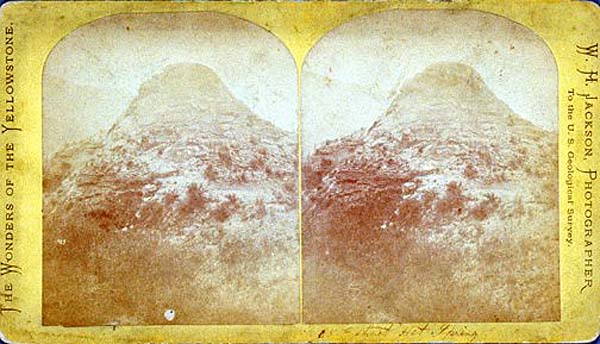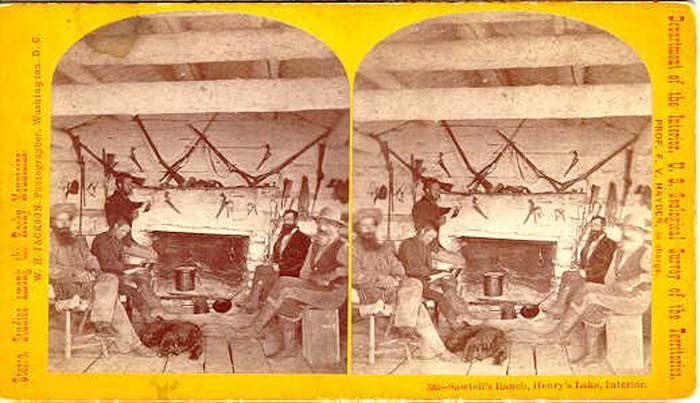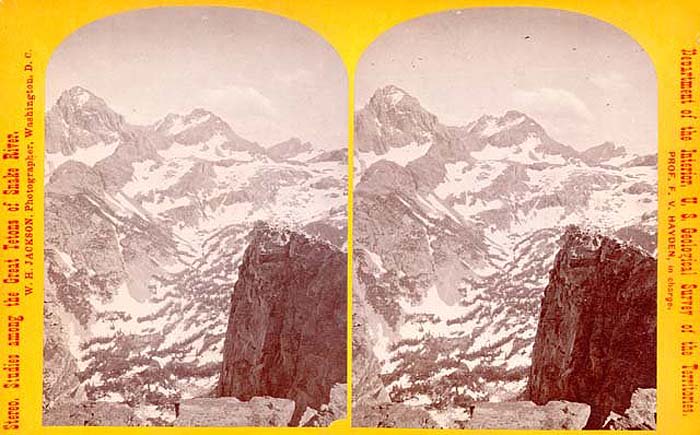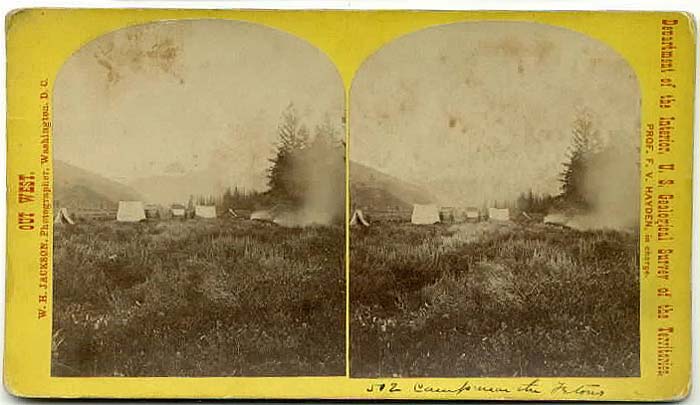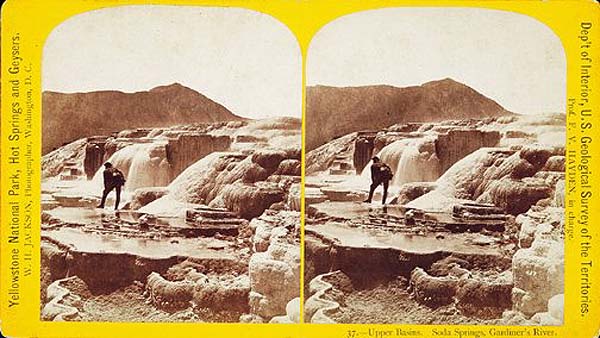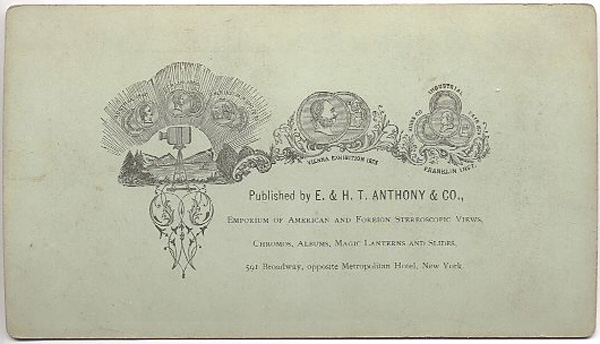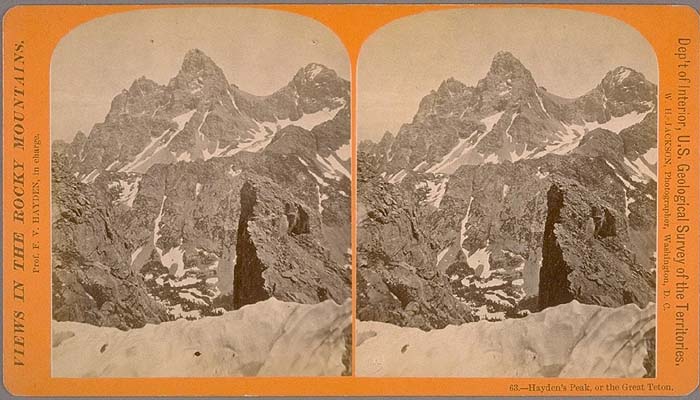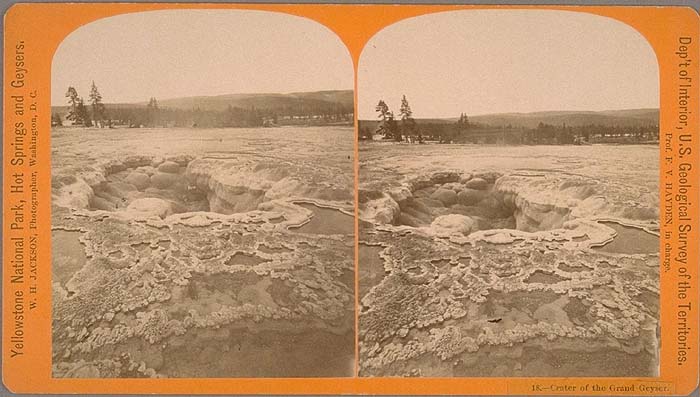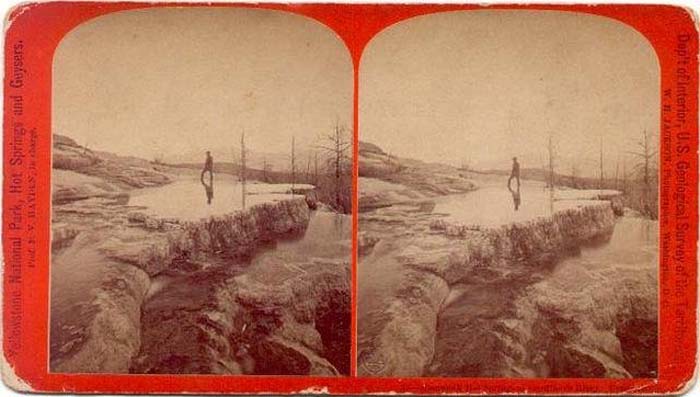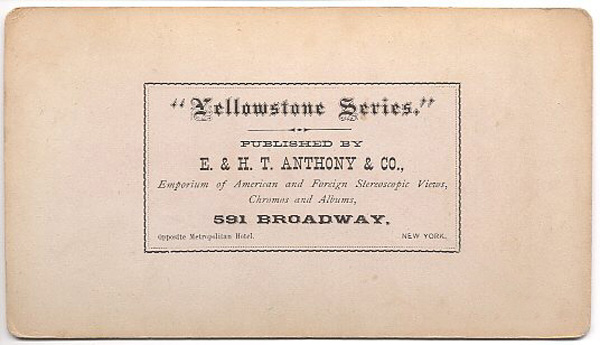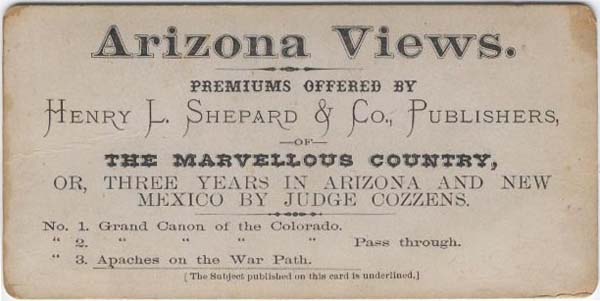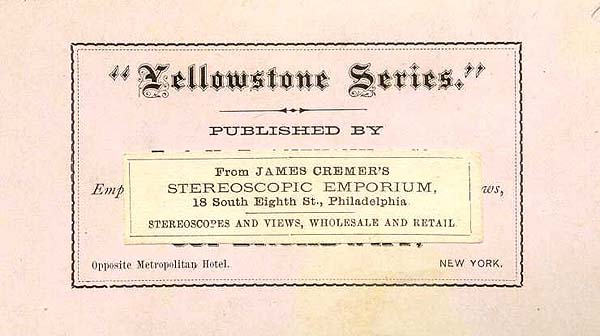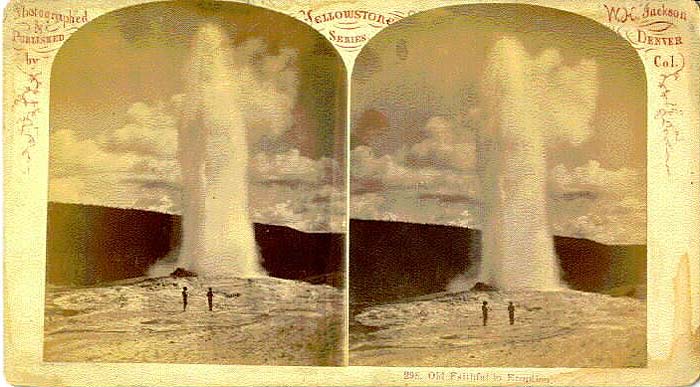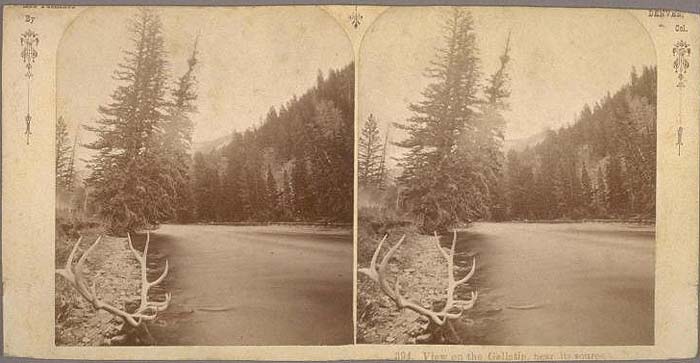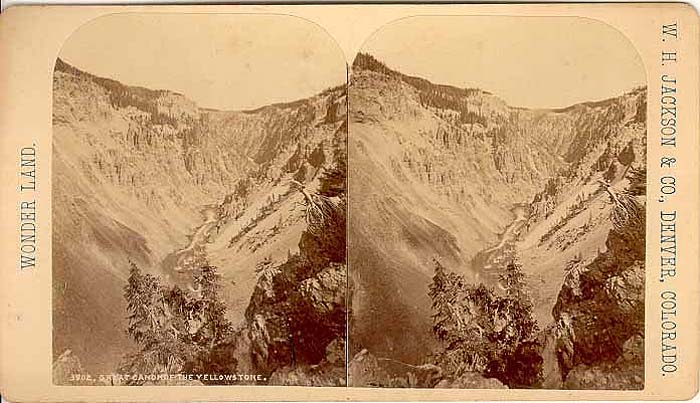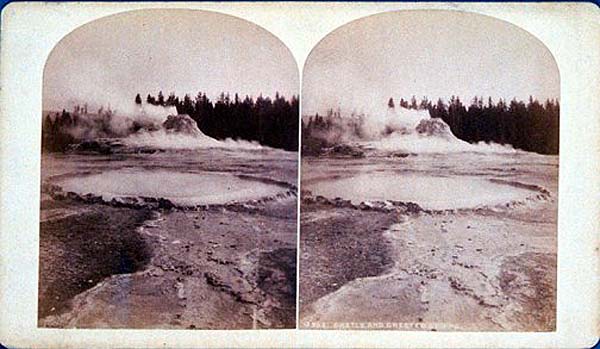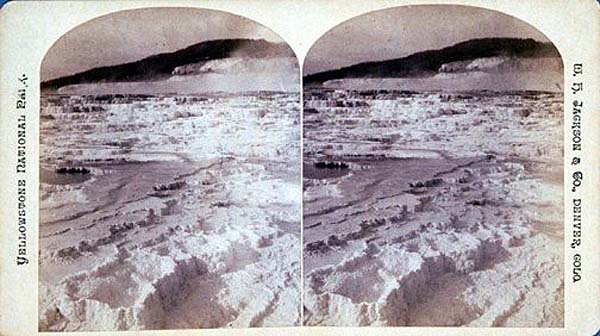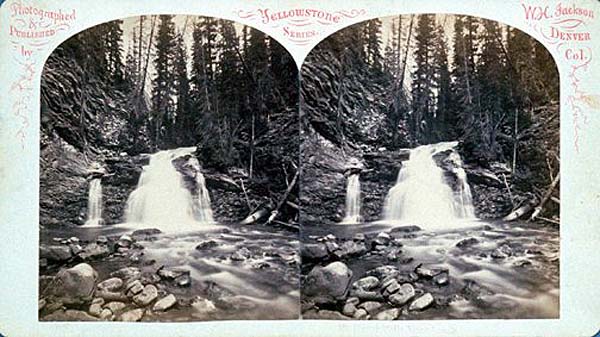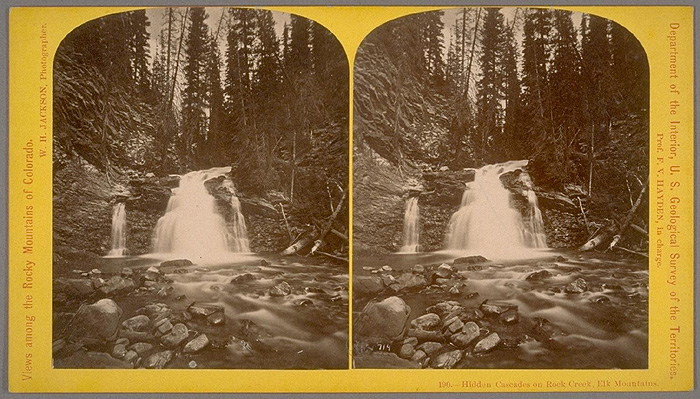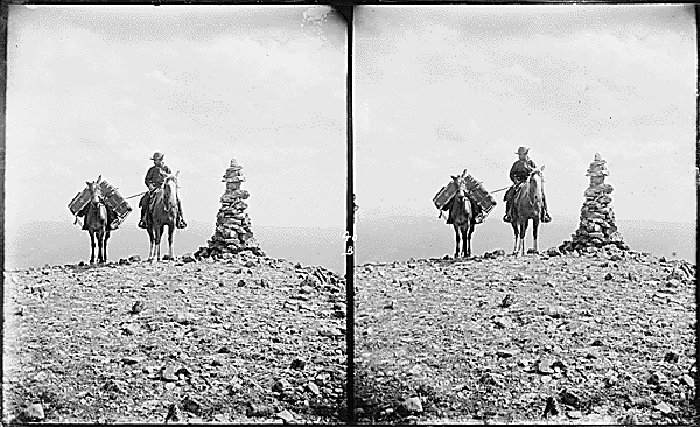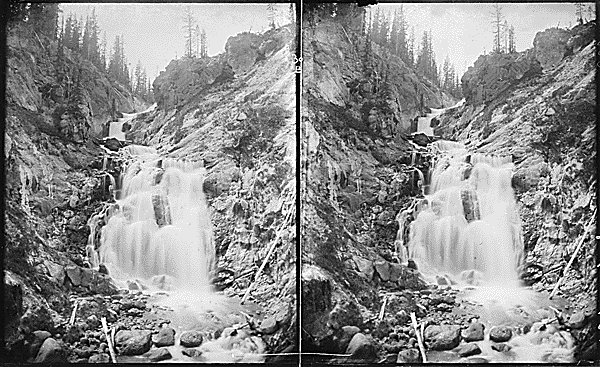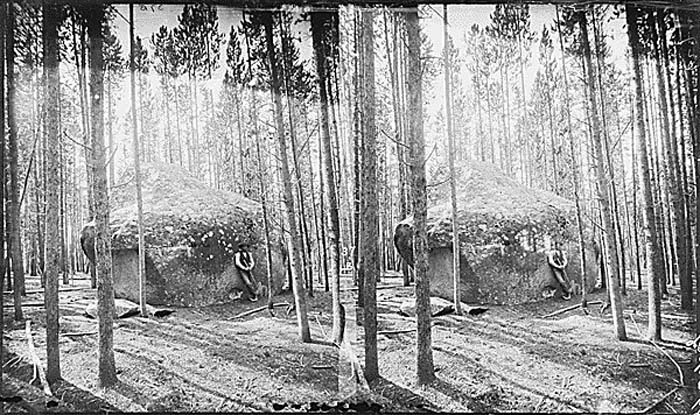
 THE
THE
YELLOWSTONE
STEREOVIEW PAGE
Yellowstone Stereoview Home /
The Views /
Yellowstone Publisher List /
Master Stereoview Checklist
12 Years in Wonderland: The Book /
Yellowstone Links /
Stereoview Links /
Collectors List /
Stereoviews for Sale
WILLIAM HENRY JACKSON
Omaha, Nebraska - Washington D.C. - Denver, Colorado
Portrait of William Henry Jackson.
Born
in Keeseville, New York, on April 4, 1843, William Henry
Jackson was a self-taught artist who, at the age of 15, was
working as a retoucher in a photographer's studio. He was
successful in this pursuit and later moved to a more prosperous
studio in Rutland, Vermont. He honed his artist's skills with
the retouching work, but also learned a great deal about the
young art of photography, a skill that would stand him in good
stead later in life. In 1860, with the onset of the Civil War,
Jackson enlisted in the Union Army. His unit spent most of its
time on garrison duty. Though present at the battle of
Gettysburg, he was stationed in the rear areas guarding supply
trains and saw no action. Mustered out in 1863, he returned to
Vermont where he went to work in Style's Photographic Gallery
in Burlington.
In
the spring of 1866, Jackson, despondent after a broken
engagement, decided to follow Horace Greeley's advice and go
west. In Nebraska City, Nebraska Territory, he was hired to
work as a bullwhacker for a freighting outfit bound for the
gold fields of Montana. Along the old Oregon Trail, Jackson
sketched the landmarks and lifestyles that have become a large
part of the American experience. After his return from the west,
Jackson opened a photographic studio in Omaha, Nebraska.
During
the summer of 1869, Jackson began photographing the construction
along the new Union Pacific Railroad. His work came to the
attention of Ferdinand Hayden who was organizing a geologic
survey to explore the mysterious lands known as Yellowstone,
and he was asked to accompany the expedition. As a result,
William Henry Jackson became one of the first photographers
to successfully capture the wonders of Yellowstone on film.
Jackson's photographs were an important factor in convincing
Congress to establish Yellowstone as our first national park in
1872.
For
the next several years Jackson accompanied other geologic
surveys of the west and southwest. In 1879 he decided to open a
new studio in Denver, Colorado, where he spent a great deal of
time photographing the railroads and the marvels of engineering
that made it possible for the trains to make their way through
the Rocky Mountains. He also became famous for photographing the
Mount of the Holy Cross - a place most people had thought
existed only in legend.
At
a time when most men consider a well-deserved retirement,
Jackson developed new interests. In 1894 he set out on a world
tour that visited Europe, Africa, India, Australia, Japan, and
Russia. He wrote his autobiography, and once again took up the
paintbrush in an effort to depict the history of the west that
he had experienced firsthand. William Henry Jackson celebrated
his 99th birthday in 1942, and died two months later on June 30,
1942. The long life of William Henry Jackson allowed him to
witness many changes in American life, and he used his artistic
skills to document those changes for succeeding generations.
A wing of the visitor center at Scotts Bluff National Monument
is dedicated to the life and work of William Henry Jackson, and
a large number of his original paintings are a part of the park's
collection, where they are used to illustrate a vital part of
our history.
It
is said that Jackson produced over 54,000 negatives in his
photographic career. Many of these were issued as stereoviews,
and of these many were of Yellowstone. His multitude of
Yellowstone view styles make Jackson one of the more complex
photographers to analyze. The styles are described below.
The 400 Series - 1871
This
set is labeled on the right side: "Scenery of the Yellowstone, 1871."
The left side is labeled "W. H. Jackson Washington D.C.
Photographer to the U.S. Geological Survey."
It is numbered from 420-466 and found on Yellow Cabinet Mounts.
460–Crater of Giant Geyser, Fire Hole Basin.
A view of Giant Geyser at Upper Geyser
Basin. These were among Jackson’s first stereoviews issued.
423–Successful Fisherman.
Another of the 1871 stereoviews. This
famous fishing scene has been reproduced many times.
The 400 Series - No Year Shown
Another
printing perhaps of the above set. This one has the same
numbering and is also on Yellow Cabinet Mounts.
The left side is labeled, "W. H. Jackson Washington D.C."
The right side is labeled, "Scenery of the Yellowstone."
430–HOT SPRINGS ON GARDINERS RIVER, LOWER BASINS.
A view of the terraces at Mammoth. This
view has no date of issue but was part of the 1871 set.
The Wonders of the Yellowstone
This
Yellow Cabinet Mount view type must be extremely scarce
because I have only seen a couple. The left side is labeled,
"The Wonders of the Yellowstone." The right side is Labeled,
"W. H. Jackson Photographer to the U.S. Geological Survey."
There is no mention of Hayden or Washington D.C. anywhere on the
view. This set must be very early (1871, 72). The titles are
hand-written on the obverse. There is no numbering on these views.
Extinct Hot Spring.
This rare Jackson view may be Soda Butte
in the northeast corner of Yellowstone.
The 500 Series, Yellow Mounts with Red Lettering
These
views encompass not only the Yellowstone, but the Tetons
and other locales around Yellowstone. On the right side they
credit, "Department of the Interior, U.S. Geological Survey of
the Territories. Prof. F. V. Hayden in Charge." Some have no
number and the titles are hand-written. There may have been
several print runs. The left side describes each series within
the overall set. Left side labels include:
Stereo, studies among the Rocky Mountains.
Stereo, studies among the Great Tetons of the Snake River.
Out West.
Views of the West Gallatin, Montana Territory.
Yellowstone National Park, Hot Springs and Geysers.
Views in the Yellowstone National Park.
Yellowstone National Park, Mammoth Hot Springs.
540-Crater of the Fountain Geyser.
This view from the set, "Yellowstone
National Park, Hot Springs and Geysers" shows the crater of
Fountain Geyser at Lower Geyser Basin.
533-Sawtelle's Ranch, Henry's Lake, Interior.
An amazing image showing the interior of
Gilman Sawtelle’s cabin at Henry's Lake, Idaho and members of
the Hayden Survey. It is part of Jackson’s "Stereo, studies
among the Rocky Mountains" set.
504–Teton Range, East.
Jackson’s Teton views are also noteworthy.
Here is one showing the high peaks long before they a were part
of a national Park.
502–Camp in the Tetons.
This scene from Jackson’s "Out West"
series, shows their camp in the Snake River Valley at the base
of the Teton Range.
Low Number U.S.G.S. Series by E. & H.T. Anthony - Yellow Mounts
This
set is nearly identical to its counterpart below except that it has
with black lettering. Unlike the other Anthony issue, this one
includes views only from Yellowstone. Also, it is numbered from
1 to at least 57 (the other goes as high as 99). The left side
is labeled, "Yellowstone National Park, Hot
Springs and Geysers." The right side is labeled, "Dept. of
Interior, U.S. Geological Survey of the Territories."
These have the elaborate Anthony reverse with artwork and
credits.
37.–Upper Basins. Soda Springs, Gardiner's River.
A classic Jackson image showing the
Mammoth Terraces. It was issued by E. & H. T. Anthony of New
York.
Low Number series by E. & H.T. Anthony - Red or Orange Mounts
This
set is numbered #1-99. It is found on Red or Orange Mounts.
These views all credit both Jackson and Hayden. Some are
untitled, but most have numbered title on obverse. These have
the E. & H.T. Anthony stamp inside a rectangle on the reverse.
They include views of Yellowstone and the Tetons.
63.–Hayden's Peak, or the Great Teton.
An Anthony image of the Tetons from
Jackson’s "Views in the Rocky Mountains" series.
18.–Crater of the Grand Geyser.
An Anthony orange mount showing Grand
Geyser Crater at Upper Geyser Basin.
35.–Mammoth Hot Springs of Gardiner's River. Upper Basins.
An Anthony red mount showing a terrace at
Mammoth Hot Springs. This view has a hand-written title on the
reverse side.
This verso shows up on many Anthony/Jackson
orange and red mounts, as opposed to the more elaborate reverse
of the yellow mounts above.
Two examples of other major publishers who
sold Anthony images with their own stamps over the Anthony
credit. Dozens of these secondary publishers probably exist.
The Denver 200 Series
Jackson
evidently made this scarce series that included
Yellowstone views. I have only recorded three of them. The title
"Yellowstone Series" appears in the top center of each view.
The words, "W.H. Jackson, Denver, Col." appear in the upper
right corner. The words, "Photographed and Published by," appear
in the upper left.
295. Old Faithful in Eruption.
The Denver 300 Series
This
odd series originally did not include views of Yellowstone
at all. However with the later boundary changes to the park, this
Montana Territory series now had views inside Yellowstone.
394. View on the Gallatin, near its source.
The Denver 3000 Series - Type 1
This
is the more common 3000 series style, its numbers range from 3901
to at least 3992. The left side is labeled, "414 Larimer Street,
Denver, Colo." The right side is Labeled, "W. H. Jackson & Co.,
Photographers." These views are all on tan mounts.
3909. MAMMOTH HOT SPRINGS.
The Denver 3000 Series - Type 2
This
is the rarer of the 3000 series styles. It is numbered from
at least 3901-3915. The views are on cream-colored mounts. The
left side is labeled, "WONDER LAND." The right side is labeled,
"W. H. JACKSON & CO., DENVER COLORADO," in blue lettering. The
titles have white lettering over the photo on the lower left
side.
3902. GREAT CANON OF THE YELLOWSTONE.
Two
other Denver styles worth noting are these white mount views. One is
a 3000 series view that is titled and numbered but has no
publisher credit. The other is labeled, "Yellowstone National
Park" on the left side, and "W.H. Jackson & Co., Denver Colo."
on the right side. It has no title but shows a terrace at
Mammoth. I don’t know if these were test runs, or part
of larger non-Yellowstone sets.
3362 CASTLE AND CRESTED SPRING
Untitled [Terrace at Mammoth]
Denver Error Views
Jackson
did have several labeling errors during his Denver
production. I have turned up views labeled "Yellowstone
Series, that are not in Yellowstone at all. One of note is
entitled: "Upper Falls, Rock Creek." This is particularly
interesting because Yellowstone does have a Rock Creek, but this
same photo shows in another series as being in the Elk Mountains
of Colorado. Therefore it is worth noting that not all Jackson
stereoviews labeled "Yellowstone," are accurate.
Cascades on Rock Creek.
190.-Hidden Cascades on Rock Creek, Elk Mountains.
The
National Archives in Washington D. C. houses many unpublished
Jackson Yellowstone stereoviews. Below are three examples.
Unpublished Jackson Stereoview
Summit of Mt. Washburn
Unpublished Jackson Stereoview
Little Firehole Falls [Mystic Falls]
Unpublished Jackson Stereoview
Glacial Boulder
WILLIAM HENRY JACKSON VIEWLIST
Yellowstone Stereoview Home /
The Views /
Yellowstone Publisher List /
Master Stereoview Checklist
12 Years in Wonderland: The Book /
Yellowstone Links /
Stereoview Links /
Collectors List /
Stereoviews for Sale

 THE YELLOWSTONE STEREOVIEW PAGE
THE YELLOWSTONE STEREOVIEW PAGE
Copyright ©2002-2018 Paul Rubinstein
All Rights Reserved.
